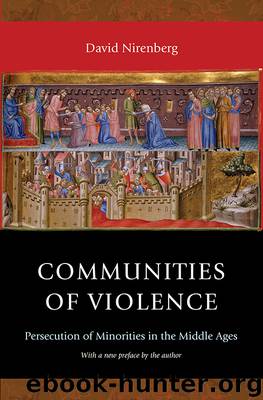Communities of Violence by Nirenberg David; Nirenberg David;

Author:Nirenberg, David; Nirenberg, David;
Language: eng
Format: epub
Publisher: Princeton University Press
Published: 2014-01-28T05:00:00+00:00
Chapter 6
MINORITIES CONFRONT EACH OTHER: VIOLENCE BETWEEN MUSLIMS AND JEWS
THE PREVIOUS CHAPTER moved from a set of anxieties arising at a particular religious boundary to the strategic deployment of these anxieties in a competitive world: a move from structure to context, so to speak. But we can also take the opposite tack and ask how particular and contingent historical situations encourage the emergence of intolerant religious discourses and give them strength. Such a vast question is best answered by example, in this case that of Muslim-Jewish relations in the Christian Crown of Aragon. Though some have found in the “horizontal” relationship between minority communities materialist conflict and violence undistorted by the screen of Christian religious discourse,1 in fact Muslims and Jews not only acted and argued out their conflicts in their own religious languages but also sought access to explicitly Christian discourses. Even when they did not seek to have their conflicts transcend the realm of the material, we should not forget that their interactions were structured by Christian institutions (economic, political, judicial, and so forth) and the ideologies supporting these. The need to function within such institutions forced non-Christians to participate in their logic and to adopt those modes of argument that were most effective within them. One remarkable consequence of this is the adoption by Muslims of Christian anti-Jewish discourse and violence in the Crown of Aragon, a filiation that will, I hope, become clear as we tread the path from context to discourse, from situations of Muslim-Jewish conflict (moneylending, meat markets, sex) to invocations of the Crucifixion.2
There are some unfortunate practical difficulties specific to the study of Muslim-Jewish relations in the Crown of Aragon that deserve mention as caveats. The first is a problem of sources. Both groups are most accessible in the documentation of their Christian kings, a documentation concerned with taxes, privileges, and criminal and jurisdictional complaints. Not surprisingly, Christian-Muslim and Christian-Jewish relations, not Muslim-Jewish ones, feature most prominently in the evidence. As for Muslim records, the emigration of elites from much of the Crown (Valencia excepted), later attempts to suppress the use of Arabic, and finally the expulsion of the Moriscos all ensured that what Arabic material survives from the period is sparse and scattered. Jewish sources, too, suffered in the expulsions of 1492 and in any case were never rich in material concerning their Muslim neighbors. When Jews did write of “Ishmaelites,” they often meant those sovereign Muslims across the sea, not the impoverished Mudejars with whom they shared a subject status within a Christian land. This lack of sources is mentioned, not by way of excuse for what follows, but as a partial explanation for the near total lack of interest historians have shown for the topic of Muslim-Jewish relations in Spain.
Herein lies a second problem. The study of minority interaction is undertaken in a historiographic vacuum. Virtually no work has been done on Muslim-Jewish relations under Christian rule in the Iberian Peninsula, so we know little of the material infrastructure of these relations.
Download
This site does not store any files on its server. We only index and link to content provided by other sites. Please contact the content providers to delete copyright contents if any and email us, we'll remove relevant links or contents immediately.
| Anthropology | Archaeology |
| Philosophy | Politics & Government |
| Social Sciences | Sociology |
| Women's Studies |
Cecilia; Or, Memoirs of an Heiress — Volume 1 by Fanny Burney(32409)
Cecilia; Or, Memoirs of an Heiress — Volume 3 by Fanny Burney(31816)
Cecilia; Or, Memoirs of an Heiress — Volume 2 by Fanny Burney(31791)
The Great Music City by Andrea Baker(31246)
We're Going to Need More Wine by Gabrielle Union(18947)
All the Missing Girls by Megan Miranda(15481)
Pimp by Iceberg Slim(14308)
Bombshells: Glamour Girls of a Lifetime by Sullivan Steve(13949)
Talking to Strangers by Malcolm Gladwell(13181)
Norse Mythology by Gaiman Neil(13167)
Fifty Shades Freed by E L James(13143)
For the Love of Europe by Rick Steves(12593)
Mindhunter: Inside the FBI's Elite Serial Crime Unit by John E. Douglas & Mark Olshaker(9155)
Crazy Rich Asians by Kevin Kwan(9145)
The Lost Art of Listening by Michael P. Nichols(7385)
Enlightenment Now: The Case for Reason, Science, Humanism, and Progress by Steven Pinker(7154)
The Four Agreements by Don Miguel Ruiz(6590)
Bad Blood by John Carreyrou(6516)
Weapons of Math Destruction by Cathy O'Neil(6116)
